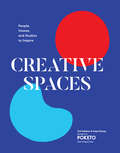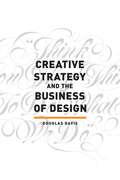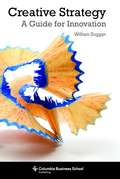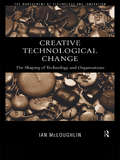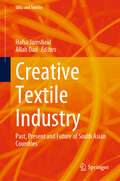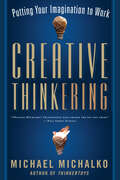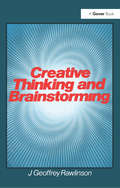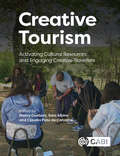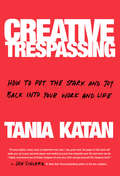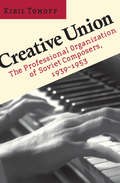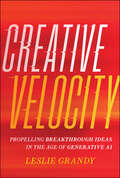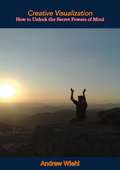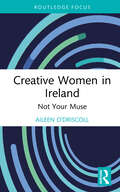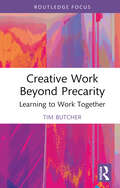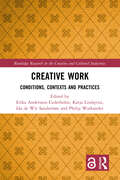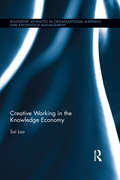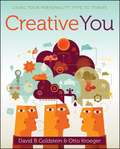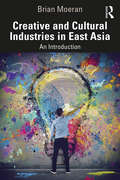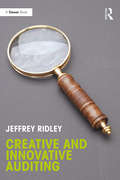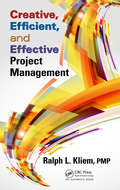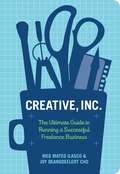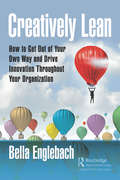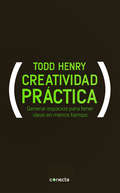- Table View
- List View
Creative Spaces: People, Homes, and Studios to Inspire
by Angie Myung Ted VakadanThis debut book from acclaimed Los Angeles lifestyle brand Poketo proves creativity can be sparked anywhere. From a colorful desk in a tiny closet to expansive homes, Creative Spaces explores the lives, homes, and studios of 23 artistic entrepreneurs, authors, and designers through a collection of inspired interiors from across the country that brings art into the everyday. With stunning photography, intimate profiles, and unexpected takeaways, the book showcases an eclectic mix of creatives, including artist Adam J. Kurtz, ceramicist Helen Levi, and DJ Chris Manak, among others. Fusing lifestyle with interior design, this peek into the spaces and lives of creative professionals will motivate dreamers and thinkers to become doers and makers.
Creative Strategy and the Business of Design
by Douglas DavisThe Business Skills Every Creative Needs! Remaining relevant as a creative professional takes more than creativity--you need to understand the language of business. The problem is that design school doesn't teach the strategic language that is now essential to getting your job done. Creative Strategy and the Business of Design fills that void and teaches left-brain business skills to right-brain creative thinkers. Inside, you'll learn about the business objectives and marketing decisions that drive your creative work. The curtain's been pulled away as marketing-speak and business jargon are translated into tools to help you:Understand client requests from a business perspectiveBuild a strategic framework to inspire visual conceptsIncrease your relevance in an evolving industryRedesign your portfolio to showcase strategic thinkingWin new accounts and grow existing relationshipsYou already have the creativity; now it's time to gain the business insight. Once you understand what the people across the table are thinking, you'll be able to think how they think to do what we do.
Creative Strategy and the Business of Design
by Douglas DavisThe Business Skills Every Creative Needs! Remaining relevant as a creative professional takes more than creativity--you need to understand the language of business. The problem is that design school doesn't teach the strategic language that is now essential to getting your job done. Creative Strategy and the Business of Design fills that void and teaches left-brain business skills to right-brain creative thinkers. Inside, you'll learn about the business objectives and marketing decisions that drive your creative work. The curtain's been pulled away as marketing-speak and business jargon are translated into tools to help you:Understand client requests from a business perspectiveBuild a strategic framework to inspire visual conceptsIncrease your relevance in an evolving industryRedesign your portfolio to showcase strategic thinkingWin new accounts and grow existing relationshipsYou already have the creativity; now it's time to gain the business insight. Once you understand what the people across the table are thinking, you'll be able to think how they think to do what we do.
Creative Strategy: A Guide for Innovation (Columbia Business School Publishing Ser.)
by William DugganWilliam Duggan's 2007 book, Strategic Intuition, showed how innovation really happens in business and other fields and how that matches what modern neuroscience tells us about how creative ideas form in the human mind. In his new book, Creative Strategy, Duggan offers a step-by-step guide to help individuals and organizations put that same method to work for their own innovations. Duggan's book solves the most important problem of how innovation actually happens. Other methods of creativity, strategy, and innovation explain how to research and analyze a situation, but they don't guide toward the next step: developing a creative idea for what to do. Or they rely on the magic of "brainstorming"—just tossing out ideas. Instead, Duggan shows how creative strategy follows the natural three-step method of the human brain: breaking down a problem into parts and then searching for past examples to create a new combination to solve the problem. That's how innovation really happens. Duggan explains how to follow these three steps to innovate in business and any other field as an individual, a team, or a whole company. The crucial middle step—the search for past examples—takes readers beyond their own brain to a "what-works scan" of what others have done within and outside of the company, industry, and country. It is a global search for good ideas to combine as a new innovation. Duggan illustrates creative strategy through real-world cases of innovation that use the same method: from Netflix to Edison, from Google to Henry Ford. He also shows how to integrate creative strategy into other methods you might currently use, such as Porter's Five Forces or Design Thinking. Creative Strategy takes the mystery out of innovation and puts it within your grasp.
Creative Strategy: A Handbook for Innovation
by William R. DugganWilliam Duggan’s 2007 book, Strategic Intuition, showed how innovation really happens in business and other fields and how that matches with what modern neuroscience tells us about how creative ideas form in the human mind. In his new book, Creative Strategy, Duggan offers a step-by-step guide to help you and your company put that same method to work for your own innovations. Duggan’s book solves the most important problem of how innovation actually happens. Other methods of creativity, strategy, and innovation explain how to research and analyze a situation, but they don’t tell you how to take the next step: a creative idea for what to do. Or they rely on the magic of “brainstorming”—you toss out ideas off the top of your head. Instead, Duggan shows how creative strategy follows the natural three-step method of your own brain: it breaks down a problem into parts, and then searches for past examples in your memory to come up with a new combination to solve the problem. That’s how innovation really happens. Duggan explains how to follow these three steps to innovate in business or any other field as an individual, a team, or a whole company. The crucial middle step—a search for past examples—takes you beyond your own brain to a “what-works scan” of what others have done within and outside of your company, industry, and country. It is a global search for good ideas to combine as a new innovation. Duggan illustrates creative strategy with real-world cases of innovation that use the same method: from Netflix to Edison, and from Google to Henry Ford. He also shows how to integrate creative strategy into other methods one might currently use, such as Porter’s Five Forces or Design Thinking. Creative Strategy takes the mystery out of innovation and puts it within your grasp.
Creative Technological Change: The Shaping of Technology and Organisations (The\management Of Technology And Innovation Ser.)
by Ian McloughlinCreative Technological Change draws upon a wide range of thinking from organisational theory, innovation studies and the sociology of technology. It explores the different ways in which these questions have been framed and answered, especially in relation to new 'virtual' technologies. The idea of metaphor is used to capture the differences between, and strengths and weaknesses of various ways of conceptualising the technology/organisation relationship. This approach offers the possibility of developing new ways of thinking about, viewing and ultimately responding creatively to the organisational challenges posed by technological change.
Creative Textile Industry: Past, Present and Future of South Asian Countries (SDGs and Textiles)
by Hafsa Jamshaid Allah DadThis book gives a comprehensive overview of the creative textile industry and its sectors involved in South Asian countries namely Pakistan, India, and Bangladesh. It provides basic knowledge about the textile, fabric manufacturing techniques, processing, and design method used for the development of creative textile products from the three countries in the past till the 1900s to the present 2023 and discusses the future challenges and prospects. It introduces the concept of a multi-species design process as the future need to obtain a sustainable product cycle of creative textile fabrics. The content of this book appeals to academic researchers, industrial practitioners, and policymakers who are interested in the creative textile industry in South Asia, its economics, and sustainability.
Creative Thinkering: Putting Your Imagination to Work
by Michael MichalkoWhy isn’t everyone creative? Why doesn’t education foster more ingenuity? Why is expertise often the enemy of innovation? Bestselling creativity expert Michael Michalko shows that in every ?eld of endeavor — from business and science to government, the arts, and even day-to-day life — natural creativity is limited by the prejudices of logic and the structures of accepted categories and concepts. Through step-by-step exercises, illustrated strategies, and inspiring real-world examples, he shows readers how to liberate their thinking and literally expand their imaginations by learning to synthesize dissimilar subjects, think paradoxically, and enlist the help of the subconscious mind. He also reveals the attitudes and approaches that diverse geniuses share — and anyone can emulate. Fascinating and fun, Michalko’s strategies facilitate the kind of lightbulb-moment thinking that changes lives — for the better.
Creative Thinking and Brainstorming
by J. Geoffrey RawlinsonBrainstorming is probably the best known of all the techniques available for creative problem solving. This book, by one of the world’s foremost exponents of brainstorming, begins by identifying the barriers to creative thinking and showing how they can be removed. It goes on to set out systematic procedures for organizing effective brainstorming sessions, for evaluating the ideas produced, and for introducing the brainstorming approach into an organization. This is a highly practical book, illustrated throughout by examples drawn from the author's experience with nearly eight hundred groups of managers in four continents.
Creative Tourism: Activating Cultural Resources and Engaging Creative Travellers
by Britta Timm Knudsen Greg Richards Kathleen Scherf Fernando Almeida Lénia Marques Fiona Eva Bakas Satu Miettinen Melanie Sarantou Elena Paschinger Diana Zuluaga Diana Guerra Jaime Serra Noémi Marujo Alexandra R. Gonçalves Sónia Moreira Cabeça Paula Remoaldo Juliana Alves Margaret Feeney João Filipe Marques Mirian Tavares Carlos Alcobia Jutamas Jan Wisansing Tiago Vinagre de Castro Ana Osredkar Catharina Sligting Rita Salvado Guida Rolo Jan Ifversen Marie-Andrée Delisle Marília Lúcio Sabrina V. Pratt Larissa Almeida Maria Assunção Gato Elisabete Tomaz Pedro Costa Ana Rita Cruz Margarida Perestrelo Maria Huhmarniemi Outi Kugapi Laura Laivamaa Maria Do BorgesThis book provides a synthesis of current research and international best practice in the emerging field of creative tourism. Including knowledge, insights, and reflections from both practitioners and researchers, it covers types of creative tourist, trends, designing and implementing creative tourism products, embedding activities in a community and place, and addressing sustainability challenges. Applying lessons learned from the CREATOUR project and other initiatives, the editors present key information in an actionable manner best suited to people working on the ground. The book: - Addresses important issues such as local economic benefit, social and collaborative economy, community engagement, social inclusion, youth empowerment, cross-cultural exchange, and responsible travel. - Provides a core, introductory text plus a wide range of cases examining creative tourism development in practice in the following 15 countries: Austria, Brazil, Canada, Colombia, Denmark, Finland, Kenya, Namibia, Portugal, the Netherlands, New Zealand, Slovenia, Spain, Thailand, and the USA. - Includes colour photos, diagrams, text boxes, and call-out quotations throughout to help guide and engage readers. A vital resource for tourism agencies, practitioners, planners and policymakers interested in developing creative tourism programmes and activities, this book will also be of interest to cultural and creative tourism researchers, students, and teachers of tourism and culture-based development.
Creative Trespassing: How to Put the Spark and Joy Back into Your Work and Life
by Tania Katan"At once playful, smart, easy to implement and, dare I say, punk rock, the pages of this book will wake you up to your personal power and remind you just how enjoyable your life, and work, can be. I highly recommend you let Katan trespass all over your sitch and get yourself this fabulous book." - Jen Sincero, #1 New York Times bestselling author of You are a Badass and You are a Badass at Making MoneyCreative disruptor, inspirational speaker, and co-creator of the internationally viral campaign #ItWasNeverADress shows you how to put the spark back into your work and life."You don't have to turn into a corporate drone to kick ass in the working world," says Tania Katan. After more than ten years of smuggling creativity into the business sector without getting busted, Katan is here to tell you that any task or pursuit can be a creative one. You just need to be willing to defy conformity and be ready to conjure imagination anywhere, at any time. If you're feeling stuck in a dullsville job, a windowless cubicle, or an ill-fitting polyester work shirt, chin up! Katan has been there, too, and she's lived to tell the story. How? By choosing to stand out rather than fit in, to find her light, and to bask in it with all of her quirks and flaws. "The moment you choose to let the world see the real you--messy, imperfect, warts and all," she says, "is the moment you choose to shine too."Whether you're an entrepreneur seeking new ways to innovate, a newbie trying to spice up routine entry-level work, a free spirit with a rich creative life outside the office looking to bring more of that magic into your job, or just someone who occasionally feels the urge to scream "Why does it say paper jam when there is no paper jam?!!," Katan will show you how to transform monotony into novelty and become more energized in your work and in the world.Peppered with stories of her own shenanigans--from organizing a wrestling match in the middle of an art museum to staging a corporate culture intervention via post-its--and lessons from the rule-breaking exploits of artists, change-makers, and totally legit business leaders alike, this book is a rollicking, uninhibited guide to using creativity as fuel for a freer and more joyful life.
Creative Union: The Professional Organization of Soviet Composers, 1939–1953
by Kiril TomoffWhy did the Stalin era, a period characterized by bureaucratic control and the reign of Socialist Realism in the arts, witness such an extraordinary upsurge of musical creativity and the prominence of musicians in the cultural elite? This is one of the questions that Kiril Tomoff seeks to answer in Creative Union, the first book about any of the professional unions that dominated Soviet cultural life at the time. Drawing on hitherto untapped archives, he shows how the Union of Soviet Composers established control over the music profession and negotiated the relationship between composers and the Communist Party leadership. Central to Tomoff's argument is the institutional authority and prestige that the musical profession accrued and deployed within Soviet society, enabling musicians to withstand the postwar disciplinary campaigns that were so crippling in other artistic and literary spheres.Most accounts of Soviet musical life focus on famous individuals or the campaign against Shostakovich's Lady Macbeth and Zhdanov's postwar attack on musical formalism. Tomoff's approach, while not downplaying these notorious events, shows that the Union was able to develop and direct a musical profession that enjoyed enormous social prestige. The Union's leadership was able to use its expertise to determine the criteria of musical value with a degree of independence. Tomoff's book reveals the complex and mutable interaction of creative intelligentsia and political elite in a period hitherto characterized as one of totalitarian control.
Creative Velocity: Propelling Breakthrough Ideas in the Age of Generative AI
by Leslie GrandyExpert guide to sharpen and revitalize your creative spirit in any business environment Written by trailblazing global product innovator Leslie Grandy, Creative Velocity: Propelling Breakthrough Ideas in the Age of Generative AI provides everything readers need to develop the mindset, skills, and confidence that allow creativity to flourish, enabling them to challenge conventional thinking to improve customer, business, and personal results and collaborate effectively with generative AI to cultivate and explore novel ideas. This book integrates Grandy's real-world examples and practical exercises with compelling insights from thought leaders and academic researchers, rooting her approach in cognitive science and providing empirical evidence of the value of these techniques. The book is an enduring reference that readers can return to whenever they need to revitalize their creative spirit. In this book, readers will learn about: Non-linear thinking methods and how to use them to explore novel possibilities Trigger mechanisms that can jump-start new trains of thought and spark disruptive ideation Different forms of play that stimulate creative thoughts, critical thinking skills, and flexibility Achieving a state of flow and how it helps identify groundbreaking discoveries. Creative Velocity: Propelling Breakthrough Ideas in the Age of Generative AI earns a well-deserved spot on the bookshelves of product leaders, business professionals, and entrepreneurs seeking to build a culture of innovation within their organizations and generate fresh ideas to solve business challenges.
Creative Visualization: How to Unlock the Secret Powers of Mind
by Andrew Wiehl“Much is said and written on the subject of visualization, but little has been told about how to visualize. My purpose is to tell how, to explain the proven methods and to give you the secrets of successful visualization.“These teachings, based upon natural laws, are simple. If you will follow them faithfully, the results may seem little short of miraculous.“Whether you develop genius, or near genius, or remain just where you are, depends entirely upon you. Wonders have been performed, seeming miracles wrought, through visualization. It is a God-given power available to anyone. Its effectiveness lies in its individual application.“As you are given the principles, study them carefully. Absorb everything contained in each lesson given. Then start immediately to put into effect the things you have learned. Apply. Start visualizing the material things you desire. See mentally your new home or car, the money you need, or whatever it is that you earnestly wish to possess or achieve.”—Andrew Wiehl
Creative Women in Ireland: Not Your Muse (Routledge Focus on the Global Creative Economy)
by Aileen O'DriscollThrough the contributions of women working in the creative industries, this timely book explores the role of creativity in their lives, the experiences that have positively contributed to and supported their creativity and their work, as well as how gendered considerations intersect with their involvement in the cultural sphere. Spanning psychology, cultural and media studies, and the philosophy of art, it builds on existing research by offering examples of the abundance of creativity residing in women working in film and television, architecture, design, music, theatre, and the performing and visual arts in Ireland. Their reflections offer a valuable counter perspective to the assumption that women are more naturally the ‘muse’ than the creator. From these conversations, some common, although at times diverging, experiences in childhood, early career and approaches to their creative work offer important insights into the nature and practice of creativity and the conditions that may best nurture and support creativity in girls and women. Providing original observations into gendered understandings of creativity, this book will be essential reading for researchers, advanced students and practitioners seeking contemporary insights on creativity, feminism and gender.
Creative Work Beyond Precarity: Learning to Work Together (Routledge Focus on the Global Creative Economy)
by Tim ButcherThis book offers an original critical evaluation of how freelance careers can be established and sustained in the increasingly uncertain global creative economy. Developing from the author’s theoretical and empirical research at the nexus of precarious work and entrepreneurial learning, it provides an in-depth understanding of why and how creatives can learn to become entrepreneurial and how this relates to creative entrepreneurship. This book traces how arts work became creative labour and explores the contemporary organisation of artistic and creative practices to understand practical alternatives to the individualised careers we currently feel responsible for maintaining. Inspired particularly by the work of Raymond Williams, creative work is reconceptualised as practice-based collaborative learning encounters through which we might put shared feelings of precarity to work towards the production and practice of alternative possibilities. Accessible and concise, breaking down complex concepts through practical examples and linking the creative process to entrepreneurial learning, this book will be of interest to students, educators and researchers studying and working in the creative economy.
Creative Work: Conditions, Contexts and Practices (Routledge Research in the Creative and Cultural Industries)
by Erika Andersson Cederholm Katja Lindqvist de Wit Sandström, Ida Philip WarkanderHow do creative workers work? This book brings together insights from a range of relevant disciplines to help answer this significant research question.Featuring case studies from the European context, contributors tap into the experiences and practices from creative workers, demonstrating their attempts to navigate a changing environment which affects spaces, identities, and professional roles. As cross-disciplinary re-thinking of work, labour processes and management practices in the creative and cultural industries, the book offers perspectives on the importance of highlighting creative work as a phenomenon and practice beyond a particular industry, market, or public sector. Providing an opportunity to expand our conception of what creative work is, the book draws on studies of a range of activities, practices and sectors that are usually included in the cultural and creative industries as well as ones that are more untraditional.The result is a volume that will interest students, practictioners, and scholars with an interest in the creative industries.The Open Access version of this book, available at www.taylorfrancis.com, has been made available under a Creative Commons Attribution-Non Commercial-No Derivatives (CC-BY-NC-ND) 4.0 license.
Creative Working in the Knowledge Economy (Routledge Advances in Organizational Learning and Knowledge Management)
by Sai LooThere is a growing interest in the knowledge economy, and the new types of job and ways of working associated with it. This book analyses how a particular group – creative knowledge workers – carry out their jobs and learn within it. Using empirical research from advertising and software development in Europe, Singapore and Japan, it develops a new conceptual framework to analyse the complexities of creative knowledge work. Focussing uniquely on the human element of working in the knowledge economy, it explores the real world of how people work in this emerging phenomenon and examines relationships between knowledge and creative dimensions to provide new frameworks for learning and working. It offers critical insights into how these workers apply their creative knowledge work capacities towards the production of innovative products and services, as well as using their creative abilities and knowledge to fashion both digital and tangible goods in the knowledge economy. Adding significantly to the on-going debate around knowledge work and creativity, this comprehensive examination will be of interest to researchers and educators in organisational learning, management and HRM and to anyone involved in devising ways to develop and support workers in lifelong and flexible creative work practices.
Creative You: Using Your Personality Type to Thrive
by Otto Kroeger David B. GoldsteinNo matter what your passion is—business, technology, science, or plumbing—this practical guide will enable you to unleash your innate creative skills based on your unique personality type and succeed in everything you do.Whether you can admit it to yourself or not, you are creative. In today’s complex world, creativity is the key to finding and living your passion. Whatever that passion is—cooking, technology, writing, or even plumbing—Creative You reveals your own personal style of creativity to help you build an environment of innovation at work and home. Discover your creative personality type with a simple quiz and detailed descriptions of the sixteen personality types. Plus, tools and techniques show you how to apply creativity to your everyday life. Drop excuses like I’m too old to start being creative and creativity is only for artists. Confidently use creativity to live your passion by using your natural style. Whether you are starting from scratch or enhancing an already developed skill, discover the creative you that you’ve been searching for.
Creative and Cultural Industries in East Asia: An Introduction (Creative and Cultural Industries in Asia)
by Brian MoeranThis book presents an introductory overview of the socio-economic organization of creative industries, focusing on the East Asian context. Establishing a theoretical framework founded on the work of Richard Caves, Howard Becker, and Pierre Bourdieu, this textbook is an accessible introduction to creative and cultural industries, drawing on examples from Japan, South Korea, and China. It both examines what is unique about cultural production in these countries and places them in a global and intercultural context. Building on themes of uncertainty and networks of cooperation, Brian Moeran looks at the role of social ties in defining notions of quality. He then analyses the positioning of individual actors, organisations, and commodities in each field of cultural production and the exchanges of economic and symbolic capital that take place between them. Examples are taken from a range of cultural and creative industries, including film, music and fashion. Overall, Creative and Cultural Industries in East Asia serves as a foundational introduction to the study of creative and cultural production in East Asia.
Creative and Innovative Auditing
by Jeffrey RidleyBringing creativity and innovation into all professions and types of auditing today, this book meets the needs of auditing practices in the future. Recent criticisms of auditing practices by financial regulators, the traditional ‘expectation gaps’ between auditors and auditees and the continuing advances in technology make it even more important today to motivate creativity and innovation in the professions of auditors, be they internal, external, quality, environmental, social, clinical and so on. In Creative and Innovative Auditing, Jeffrey Ridley studies all auditing practices, not just internal auditing, using an innovation model he has developed through research which is applicable to all auditing organisations and professions. He shows how motivating innovation in auditing practices will address the needs of today and tomorrow’s auditing of governance, risk management and control.
Creative, Efficient, and Effective Project Management
by Ralph L. KliemCreative companies are distinguished by their ability to adapt and thrive in a dynamic, changing economy. Their products and services stand out in the market, and these companies' ability to be agile and innovative is key to their success.Creative, Efficient, and Effective Project Management supplies an in-depth discussion of creativity and its rel
Creative, Inc.
by Joy Deangdeelert Cho Meg Mateo IlascoAs the hipster classic Craft, Inc. did for crafters, this book will teach all types of creatives illustrators, photographers, graphic designers, animators, and more how to build a successful business doing what they love. Freelancing pros Meg Mateo Ilasco and Joy Deangdeelert Cho explain everything from creating a standout portfolio to navigating the legal issues of starting a business. Accessible, spunky, and packed with practical advice, Creative, Inc. is an essential for anyone ready to strike out on their own.
Creatively Lean: How to Get Out of Your Own Way and Drive Innovation Throughout Your Organization
by Bella EnglebachYou know your organization needs creativity. Your improvement program is effective, but you’re not making the real breakthroughs you were anticipating. Your employees struggle to create innovative change, while you struggle with how to help them. Your lean advisors talk about a "different way of thinking," but how do you get there? In this unique and uplifting book, Bella Englebach shows how the principles and tools of Creative Problem Solving drive deep and creative thinking when used with lean problem-solving approaches. In this book, you will learn how you can encourage creative thinking, how to support the creative thinking of your peers and employees, and how to help everyone in your organization develop high-value insights to advance strategy. Amid a lean deployment, Beth, a mid-level manager, is shocked to find that she has been assigned not one, but two coaches. Linda is her lean thinking coach, Carlo, a coach in Creative Problem Solving. As Beth faces serious business challenges, Linda and Carlo guide her to think deeply and creatively to solve problems and to become a strong lean thinking leader. You will follow her journey and see how Creative Problem Solving tools enhance lean thinking at every step. Creatively Lean is your roadmap to going beyond as a lean thinker and leader. Creatively Lean is more than a business novel. Appendices provide insight into the history of Creative Problem Solving, tools for divergent and convergent thinking, and tips on how to use Creative Problem Solving with A3 thinking. Use the book club questions to spur group discussion or for self-study.
Creatividad práctica: Generar espacios para tener ideas en menos tiempo
by Todd HenryCreatividad práctica ofrece un método eficaz para que el lector descubra su propio ritmo creativo en su actividad cotidiana, ya sea diseñador, consultor o simplemente un «creativo accidental». Solemos pensar que los procesos creativos deben reservarse para situaciones extraordinarias, mientras que en el día a día nos vemos empujados por una actividad frenética que deja poco margen para la creatividad. Sin embargo, los niveles de exigencia en nuestro trabajo nos obligan a innovar de forma constante, independientemente del tipo de actividad a la que nos dediquemos, de ahí, la importancia de estimular todo nuestro potencial creativo. En opinión del experto en creatividad empresarial Todd Henry, todo proceso creativo es rítmico; nunca conseguiremos generar mejores ideas de una manera sostenida simplemente trabajando más horas. Resulta imprescindible introducir en nuestra rutina espacios para los procesos creativos, en lugar de esperar a que se filtren entre los resquicios de una agenda de trabajo de locos. Encontrar mejores ideas, trabajar más rápido y sin estrés. Reseñas:«Un libro de incalculable valor para todo aquel que ejerza un trabajo intelectual.»Seth Godin, autor de La vaca púrpura «Este libro generará dos versiones diferentes de su lector: la primera, antes de leerlo y la segunda, después, con una capacidad potenciada al máximo.»Ricardo Crespo, vicepresidente senior y responsable global de creatividad, 20th Century Fox FCP «Creatividad práctica me sorprendió porque resulta práctico y relevante para cualquiera que tenga responsabilidades creativas. Contiene innumerables ejemplos.»Tim Hale, vicepresidente senior de marketing y diseño, Fossil «¡El mito del creativo excéntrico ha muerto! Henry Todd convierte el misterioso proceso de crear en un método brillante y controlado.»Richard Westendorf, director creativo, Landor Associates
